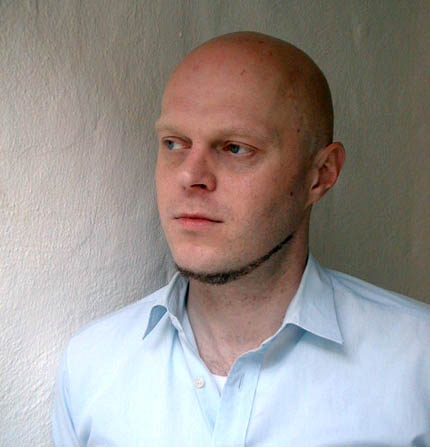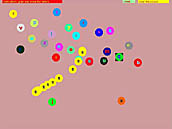|
[August 29th 2001]

Attention, please
Petri Raappana exhibits
three computer works on the first floor of the exhibition space
Overgaden on Christianshavn in Copenhagen from the 4th of August
to the 2nd of September 2001.
Kristine Ploug conducted an interviewed by
e-mail to find out what it's all about. Translated by Sophie
Pucill.
I would like you to - in your own words - describe what your
present work is about.
The exhibition at Overgaden is made up of three works. The two
alphabet works on the little computer are primarily made for viewing
at music venues. These are shown at Overgaden as a supplement to
the work "Attention", which has been created especially
for this exhibition. Both versions of AlphaByte are made as drawing
programs but also function as music-sampling programs. The difference
between "AlphaByte (vocals and some other letters..)"
and "AlphaByte (jazz)" is that one consists of sounds
from techno music and the other of sounds from jazz music. This
work is the result of collaboration with a techno musician (Michael
Thin Noeddelund, 2000) and a jazz musician (Thomas Agergaard, 2000).
Both versions of AlphaByte are based on a place specific strategy,
on socio cultural aspects and on language.


As a viewer one has to be active. The way I experience it, you
click around without knowing whereto or why. In one piece you move
letters of the alphabet around on a screen without really understanding
the system and in the other piece statistics appear, related to
the random choices the user makes. In both works the movements and
choices of the user result in music. What importance does the confusion
on the part of the viewer have, for the experience of the artwork?
Is confusion a part of the project?
'Attention' is built up in such a way so that the user doesn't
immediately understand why certain effects and situations arise.
This strategy creates a situation, which can give the user a sense
of detachment, confusion or helplessness, when faced with the functions
of the work. But as a contrast to this impression "Attention"
also presents a puzzle-like situation in the form of a fragmented
city map that the user in turn is asked to make complete. The situation
has an effect on the user, which is almost like instinctive, a need
or a wish to create order, surveillance or control disorder. I partly
got the idea for "Attention" when looking at statistics.
Statistics are a way of reducing a large amount of information,
to do with things like certain actions or behaviour, and converting
these into charts, graphs and other mathematical forms. Siegfried
Kracauer [1889-1966 red.] used a theoretical term "Ornaments
of the Mass" that describes the image of a mass of people carrying
out the same movement in synchrony. These images can look like a
military parade or a band of cheering supporters. In these images
the individual is reduced from being his or her own character or
value to being only a part of the greater picture, exactly like
a single tile on the roof of a building. The work "Attention"
is a way of talking about a certain visual language and perception,
which tends to reduce subjects and to render reality as something
made functionally and technically intelligible. But as I have said
earlier, this work also shows a situation that might describe a
need or instinct for controlling and unifying what is fragmented.
The two AlphaByte works are to be shown at music venues - I'll
look forward to seeing them…. Is computer art especially suitable
for breaking out of the conventional exhibition spaces and entering
into new contexts and relations?
The "AlphaByte" work was firstly made to be shown at
music venues but has also been shown in more ordinary exhibition
spaces. Part of contemporary art is shown, and formed, to function
within traditional exhibition places and contexts. The positive
thing about this is that the art work here can take on a different
content and have a different form than what you would expect in
more traditional set ups.
What is fascinating about mixing technology with art?
Technology is just a "tool" that art makes use of. This
does not mean that they have to be a mix but more that they can
be part of each other. Film is a marvellous example of this. Interactive
computer art has a physical character reminiscent of performance
and events. These works involve their audiences in a way that a
more static work of art can't. They can give people an immediate
sensory influence, as the user makes his or her choices, and at
the same time the work partly governs those choices.
Find:
AlphaByte
(vocals and som other letters)
"AlphaByte" will also be shown at the
following exhibition:
"Contingency/Kontingenz/it could be otherwise"
Stengade 30 in Copenhagen N
Arranged by "12-18", Molotow, Hamburg.
The 16th of September 2001 from 14:00 -20:00.
Petri Raappana was born in 1966 in Finland. Educated
at The Royal Danish Academy of Fine Art in Copenhagen from 1991-1998
and HBFK, Hamburg, from 1994-1995.
|